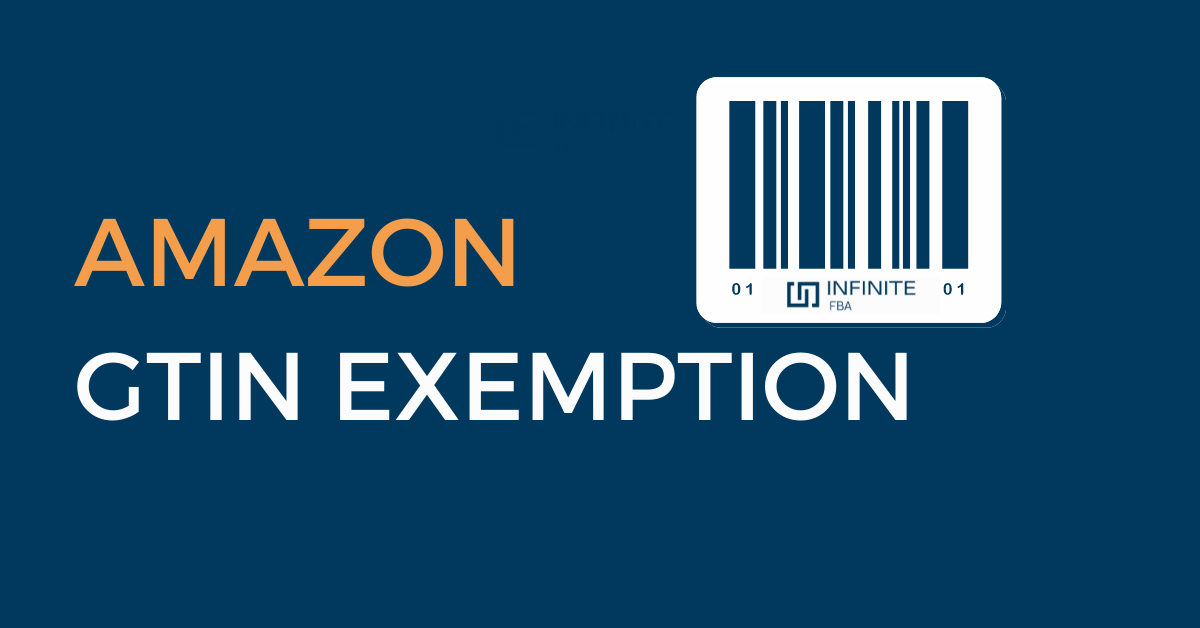GTIN Exemption and How to Get It
As a seller on Amazon, you must have a GTIN (Global Trade Identification Number) for your products. However, you need not worry if any of your products do not have one, as you can seek an exemption from the e-commerce giant. To do this, you also don’t need help from seller support, where you may need to enter details like the product name, brand, manufacturer, category, SKU, and the like.
By going through this Amazon GTIN exemption guide, you will know what GTIN is and how to get an exemption.
What is GTIN? Is It a Product ID?
As suggested earlier, GTIN, also known as Product ID, stands for Global Trade Identification Number. The unique number is present on every product you sell on Amazon as a barcode at the bottom of the package. Therefore, you can use a barcode scanner to know the product’s GTIN or product ID.

Almost every product that you sell on Amazon comes with different GTINs or IDs. You have five identification numbers to help you find products depending on the category, brand, name, and manufacturer.
1. UPC
UPC (Universal Product Code) is one of the widely used product IDs in the US and Canada. Also called GTIN-12 is the most common barcode that you can find in both online and retail stores worldwide.
2. EAN
EAN (European Article Number) is a product ID mainly used for items sold in the European markets. Also called GTIN-13, EAN consists of 13 digits and is detectable by a barcode scanner.
3. JAN
JAN (Japanese Article Number) codes are used only for products sold across Japanese markets. You may not need this for individual and professional sellers unless you are from Japan.
4. ISBN
The ISBN product identifier is used for books and stands for International Standard Book Number. In general, ISBN codes have between ten and 13 digits and consist of the publishing dates.
5. GTIN-14
GTIN-14 product codes are meant for FBA shipping containers.
How to Get a GTIN Exemption from Amazon?
Amazon lets you get a GTIN exemption even if you don’t sell products or brands under your name. Most products you sell on Amazon require a GTIN or Product ID since they have GS1-approved barcodes. However, a few products don’t need a GTIN. For instance, items for which the brand owner does not provide a GTIN.
Similarly, another instance where you don’t have or need a GTIN is selling products under your brand name.
You could also sell products that don’t require or have a GTIN, such as car spare parts or accessories. Moreover, if you sell these products in bulk, you don’t need a GTIN. In these cases, you do not need to worry about the Amazon GTIN exemption.
If you want to know what products you can sell on Amazon without a GTIN, read the overview of category requirements and UPC exemptions to understand the rules better. As a brand owner, you must do this before you start a business.
Also, if you are planning to sell products that require a GTIN but want to sell them without one, you may need to get the necessary permissions and approvals at the category level. You can find more information about how to list such products by visiting the Overview of Categories pages.
However, if you don’t own a brand or product, but want to sell on Amazon, here’s how you can get a GTIN exemption. Please keep in mind that you will get an exemption approval notice when you are done. Until then, you should keep all the information you used to apply for GTIN exemption.
Guidelines for a Brand Owner to Apply for GTIN Exemption
If you want to know whether the products you are selling require a GTIN, you can check Amazon’s catalog to see under what category the product is listed. For example, if the product you are selling comes under the ‘Exemption’ category, then it means that the item you are about to detail doesn’t already exist.
However, if the product exists under Amazon’s listings, you can check if that item requires a GTIN or Product ID. You can also check for those exempt from GTIN products and add them to your list under ‘Manage Inventory’ on the ‘Seller Dashboard.’ You can find these options through your Seller Central account.
Also, if the product doesn’t match the requirements, you can request Amazon for a GTIN exemption before adding it to the list.
As for listing the products, you must mention each item’s name and provide at least two images at different angles. When you upload the image, make sure also to put up the packaging image.
Here’s how to do this as a seller.
1. The brand name you enter should match the exact brand name present on the packaging.
2. The images you upload must be real-world and show the handling of the package or item.
3. The product or its packaging should contain the brand name.
4. Make sure that you don’t put an approved GS1 barcode as that can cause negation of the exemption.
If you ever get the brand name wrong, you can reapply by correcting it.
Reseller Guidelines
As a reseller, you need to follow different guidelines for applying for a GTIN exemption. Amazon’s seller platform differentiates between sellers and resellers by having different guidelines in place for each. The guidelines you must follow as a reseller include:
1. You must provide the addressee’s name or the person who writes the letter along with their contact details.
2. You must specify why you need a GTIN exemption.
3. You must provide your name, address, and contact details.
So, these are the guidelines you must follow as a reseller on Amazon. By going through the following sections, you will know how to apply for a GTIN exemption.
You can follow these steps to apply for a GTIN exemption.
1. Log in to Amazon Seller Central and click on ‘Apply for a GTIN Exemption.’
2. Here, click on ‘Select’ and choose the relevant product category.
3. Then, select the brand type if you are selling unbranded items, type ‘Generic’ into the respective field. Also, be sure to spell the brand name correctly by paying attention to capitalization and special characters.
4. Then, click on ‘Check for Eligibility.’ If the product does not require a GTIN, it will return ‘ineligible’ once you click on the ‘Check for Eligibility’ option. If not, proceed to the next step by clicking on ‘Continue.’
5. Once you choose ‘Continue,’ you can upload the supplement letter. Or, you can also select ‘No,’ and provide the product name and upload the images.
Note that the e-commerce giant can take up to 48 hours to respond to your application. So, you must be patient until then.
The FNSKU Label
When selling on Amazon, your product must contain the Amazon barcode or the FNSKU label. You need this label even if it means that your product is exempt from GTIN. The GTIN exemption label helps Amazon find the product in the FBA warehouse.
You must label the products when you choose the shipping method. You have two ways to do this include: Labeling the products yourself or letting Amazon do it for you by paying a fee.
You can visit the dedicated ‘Label Product’ section and print the labels to do the labeling yourself. After doing this, you can download a PDF copy and hand it to your designer to attach to the package. By doing this, you avoid labeling each product you want to sell, as the packages from a particular category contain the same label under the barcodes.
If you want Amazon to do the labeling for you, then, to find your package, you can do the following:
1. Go to ‘Manage Inventory’ on the seller platform.
2. Scroll down to find your product.
3. Here, you will find a drop-down menu to the right that consists of an option called ‘Print item labels.’
4. Click on this option, and you should be able to find your product.
How to List Products on the Amazon Seller Platform?
There are various ways to add or list products on the Amazon seller platform. However, two such methods include listing individual products and listing them in bulk. So, here’s how you can list products individually and in bulk on Amazon’s seller platform.
1. Listing Individual Products
The seller platform lets you list products individually or one-by-one, without having to enter the ID or type, provided you have a GTIN exemption. To do this:
a. Navigate to the ‘Inventory’ section.
b. Select ‘Add a Product,’ and then, ‘I am adding a product not sold on Amazon.’
c. Enter all the necessary information.
d. If you have not already filed for a GTIN exemption, you can do so, but note that you must wait for at least half an hour before listing a product by following the method in Step’ a’ and ‘b.’
e. Once you list the product, add a brand name to it. That is, add your brand name. Also, check if the brand name is valid. If the Product ID field is red, then it means that you have entered an invalid brand name or one that is already present.
f. After doing this, fill in all the required information, click on the ‘Next’ option, and save the changes.
The product you listed should go on sale after saving the changes and the attributes apply to it.
2. Listing Products in Bulk
As suggested earlier, you can also add products in bulk by uploading them to the seller platform. Like individual listings, you do not need to input the Product ID and other vital information if you already have a GTIN exemption. To do this, you must:
a. Navigate to the ‘Inventory’ section.
b. Select ‘Add products via upload.’
c. Then, select the ‘Download an inventory file’ tab.
d. After you do this, navigate to the ‘Search Tool’ section and search for the product type you want to list by keying it in and selecting the appropriate option.
e. Next, check to see if your product needs a UPC exemption. The item that you are about to list may not need a UPC exemption if you have already applied for and have a GTIN exemption. You must also ensure that it is not a restricted product category by clicking on the ‘Select button.
f. If you need category approval to list the product, you must choose the ‘Request Approval’ option.
g. After selecting all the suitable options, you can choose the template you want for your listing and select ‘Generate Template’ to finish the process.
GTIN Expiry
All GTIN exemptions filed before August 24, 2018, are subject to expiration, and so you may need to reapply for them. However, if you have filed for a GTIN exemption after this date, you can rest assured that they will not expire. You can check this by visiting the GTIN exemption page and looking at your case log file.
What are the Differences Between GTIN and UPC?
Technically, there aren’t any differences between GTIN and UPC, and that it is a Universal Product Code. Similarly, EAN and ISBN are GTINs as well. However, GTIN is a unique number.
For instance, when you talk about a GTIN-12, it is nothing but a 12-digit UPC. Here, the first six to nine-digit are the company prefix. A company prefix remains constant and is unique to the products of a said company. The last digit in a UPC is the check digit, and you can get the check digit by calculating all the 11 digits that appear before it. The digits present in the middle of the UPC are unique numbers assigned to identify the product.
EAN and GTIN
EAN (European Article Code) is a 13-digit GTIN code used worldwide, except in the US and Canada. Also, EAN codes have been replaced by GTIN. One of the primary differences between EAN and GTIN codes is that while GTIN codes can be embedded in two dimensions, EAN codes are primarily embedded in only one dimension.
Typically, a GTIN-13 code consists of 13 digits where the first two digits are country codes, and the next five digits are the manufacturer code. Similarly, the last digit is the check digit, while the remaining seven digits are free digits that you can select for making a sequence or code.
ISBN and GTIN
The digits of an ISBN lie between ten and 13. You can also transfer them to a barcode just as the UPC or EAN. If you want to get the ISBN of a particular book, you must look for the Universal Agency for Book Numbers, find it in any 160 ISBN agencies worldwide, or visit the official ISBN website.
Why Do You Need a GTIN?
Any product sold on Amazon and These identification numbers help differentiate one product from the other and help find it. Note that the UPIs (unique product identifiers) are the same even for resellers and are assigned by the manufacturers.
GTINs are the most common UPIs that help you find different products and information, such as those associated with those items. Moreover, UPIs such as GTINs also help customers locate the products they purchase and adding them can spruce up the value factor to your listings. However, you should know that some products don’t come with UPI.
What Products Require GTIN?
If you want to find products that need GTIN, you can search for them using the following attributes: GTIN or product ID, brand name, and MPN. Some products that need identifiers such as GTIN include:
- Bundled Packages
- All compatible third-party or refurbished products.
- Customized or personalized products.
- Magazines and other such Books
- Medicines
- Bundled products from the same brands or product lines.
- Printed music such as those found on CDs and DVDs.
- Printer cartridges.
- Products that come in different shapes, sizes, and colors.
- Private-labeled or relabeled products.
- Old, used, and vintage products.
How to Write GTIN?
When you write the GTIN, you must ensure that you get the format right. To write the GTIN correctly, you must:
1 Use the Correct Number of Digits
Make sure that you write the correct number of digits. For instance, you must have 13 digits for an ISBN and EAN. Similarly, for GTIN-12, you must write 12 digits. This applies to when editing existing product detail as well.
2 Use Only Numbers
GTIN is a unique product identifier consisting of only numbers. So, make sure that you use only numbers and not letters or special characters.
3 Don’t Forget to Write the ‘Check Digit?’
You can use the check digit to verify the accuracy of the GTIN using a GS1 digit calculator. Again, you should have the correct information regarding the product ID, even if you are into private label products.
4 Use the Right Levels
Ensure that you use the proper levels for packaging digits. For example, in a GTIN-14, the package identifier should consist of numbers from one to eight. So, you shouldn’t include digit nine, which is a bulk package indicator.
5 Don’t Submit a Reserved GTIN Code.
Don’t assign GTIN numbers that have already been given or are reserved for the future.
Conclusion
When you apply for a GTIN exemption, be sure to know about the process first. Ensure that you know how to apply for a GTIN exemption before you do so. The process to get is simple if you know what to do and how to do it.
However, suppose you are still unsure about applying for a GTIN exemption when you sell products on platforms like Amazon. In that case, you might as well list them by labeling them or entering details like the brand and product names and other such vital information.
We also believe our guide will help you update the existing product detail page. We have also mentioned how you can deal with private label products with a different type of product ID.
Related Posts:





